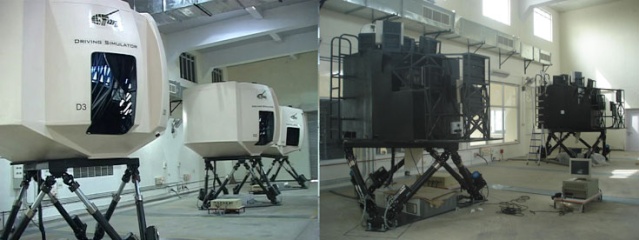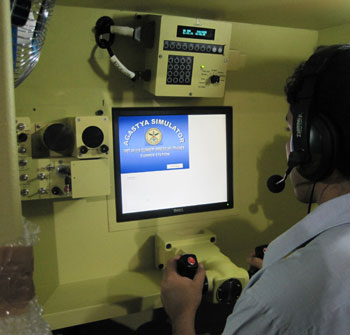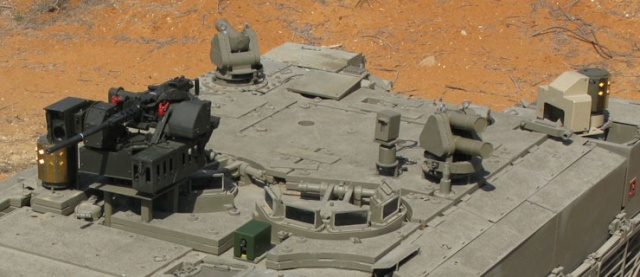Quantum LeapArjun Mk2 will be more expensive with higher import content than its predecessorBy Prasun K. Sengupta

For all intents and purposes, the Arjun Mk2 main battle tank (MBT) — currently under development since mid-2007, will be more expensive and have a higher imported content than its predecessor, the Arjun Mk1. But in terms of mobility, protection and firepower, the Mk2 variant will come closest to what Indian Army HQ wants: an MBT with highly enhanced crew protection and maximum survivability in high-intensity, fire-saturated combat environments. To achieve this, the Defence Research and Development Organisation’s (DRDO) Avadi-based Combat Vehicles Research and Development Establishment (CVRDE) has roped in both Israel Military Industries (IMI) and Elbit Systems of Israel, with the former being responsible for improving the existing Arjun Mk1’s design plus mobility and fuel consumption, redesigning and modifying the various components of the MBT’s hull and turret, and providing consultancy for improving production-line processes. Elbit Systems, on the other hand, will enhance the MBT’s firepower and its accuracy, and provide survivability systems and air-conditioning hardware. The existing Arjun Mk1 MBT, which was formally inducted into the Army’s 75 Armoured Regiment on March 12, comes powered by a MTU 838Ka-501 diesel engine (rated at 1,400hp) coupled to a RENK RK-304A transmission, and can achieve a maximum speed of 70 km/hr (43 mph) and a cross-country speed of 40 km/h (25 mph). A total of 124 Mk1 variants are on order, and will be followed by 124 Mk2 variants, which were ordered by Army HQ on May 17 last year. The Arjun Mk2 will incorporate a total of 93 upgrades, including 13 major improvements. Rollout of the first prototype will take place by this June, and by 2013, the first 30 production-standard Arjun Mk2s will roll out from the Avadi-based, ministry of defence-owned Heavy Vehicles Factory (HVF).

Work on developing the Arjun Mk2 began in the second half of 2007 soon after joint R&D contracts were inked between the CVRDE and the consortium of IMI and Elbit Systems. On October 31 that year, the CVRDE floated domestic and global expressions of interest for the co-development of a 1,500hp compact high specific power output diesel engine incorporating a state-of-the-art direct fuel injection system, digital electronic controls, turbo-charging, charge air cooling, safety controls and a pressurised multi-stage air-cleaning system; and for a hydro-kinetic automatic transmission with four forward and two reverse gears. Respondents to the CVRDE included Finland-based Wartsila (offering its V8X-1500 1,500hp hyperbar diesel engine coupled with either SESM of France’s ESM-500 transmission or US-based Detroit Diesel Allison’s X-1100-3B transmission), US-based General Dynamics Land Systems offering the EuroPowerPack comprising MTU of Germany’s MT-883 engine along with Renk’s HSWL-295TM transmission, UK-based Perkins proposing its CV12 Condor diesel engine coupled to with the ESM-500 transmission, and US-based Cummins offering a customised QSK-38 liquid-cooled, direct-injection engine coupled to the ESM-500. In late 2009, a combination of the QSK-38/ESM-500 powerpack was selected as the winner, following which Cummins India began customising this powerpack design. The ESM-500 automatic transmission, with five forward and two reverse gears, contains a planetary gearbox with shifting, steering and braking systems. It is also equipped with a hydrodynamic steering system, which allows
different turning radii depending on engine speed and selected gear. The braking system contains of two stages. As a parking brake and for a speed of up to 35kph air cooled disk brakes are used. At higher speeds a retarder is used. In addition, the transmission is equipped with a power takeoff for the cooling fans of the powerpack. Also, a hydrokinetic retarder can slow the MBT down at a decelleration rate of 7 metres/square second (0.7g), which can be very useful at the last moment before it could be hit. Supplementing this powerpack will be an indigenously developed auxiliary power unit (APU), which will provide power when the MBT is on ‘silent watch’ for battery recharging and night observation, with full systems operating while the main engine is shut down.
For ensuring MBT survivability, the Defence Metallurgical Research Laboratory (DMRL) — located in Kanchanbagh, Hyderabad — has developed a Mk2 variant of its Kanchan modular armour, which was made by sandwiching composite panels (ceramic, alumina, fibre- glass and nickel-alloy) between rolled homogenous armour (RHA) plates to defeat APFDS or HEAT rounds. At the same time, the DRDO’s Pune-based Composites Research Centre (CRC) and the Research and Development Establishment, Engineers [R&D E(E)], have developed multi-layered multi-functional fibre-reinforced polymer (FRP) composite hull/turret sub-structures at much lower weights in comparison with metallic counterparts. More than 40 per cent weight savings over steel hull structures have been achieved. Also developed for the Arjun Mk2 is co-cured composites integral armour (CIA), which comprises ceramic tiles and rubber sandwiched between two FRP composites layers. While the outer FRP composite layer acts as a cover and provides confinement, the ceramic layer provides primary protection against ballistic impact, and the inner FRP composite layer acts as the structural part as well as secondary energy absorbing mechanism. The rubber layer isolates stiff and brittle ceramic tiles from structural member.

The CVRDE, with IMI’s help, has also redesigned the Arjun Mk1’s turret to incorporate modular sloped armour fittings, and has developed a slat-armour package to protect the MBT against anti-tank rocket-propelled grenade (RPG) attacks. It functions by placing a rigid barrier around the vehicle, which causes the shaped-charge warhead (which uses a shaped-explosion rather than kinetic energy) to explode at a relatively safe distance. For protecting the Arjun Mk2 against tandem-charge PRGs and guided anti-tank missiles, the CVRDE and IMI have co-developed a lightweight non-energetic reactive armour (NERA) package, comprising tiles in which two metal plates sandwich an inert liner, such as rubber. When struck by a shaped-charge’s metal jet, some of the impact energy is dissipated into the inert liner layer, and the resulting high-pressure causes a localised bending or bulging of the plates in the area of the impact. As the plates bulge, the point of jet impact shifts with the plate-bulging, increasing the effective thickness of the armour.
For ensuring fool-proof protection against new-generation anti-armour guided-missiles, the Arjun Mk2 will incorporate both multi-threat warning sensors and an active protection system (APS). The former, supplied by Elbit Systems, comprises four E-LWS sensors that can detect, categorise and pinpoint laser sources, including rangefinders, designators, beam-riders, and infra-red illuminators. E-LWS also enables direction indication for all threats, as well as audio and visual warnings. It is immune to reflection, gunfire, lightning, fire and self-electro-optical operations. The Iron Fist APS, being supplied by IMI, uses two fixed radar sensors to detect potential threats and measures distance and trajectory for providing the APS’ fire-control system (FCS) with data for calculation of engagement plans. The FCS uses two ELTA Systems-built conformal, distributed radars and an infra-red sensor called Tandir, developed by Elbit Systems. When a threat is identified as imminent, an explosive projectile interceptor is launched toward it from either of the two twin-tube rotating launchers housing fin-stabilised launch cannisters. The interceptor, shaped similar to a small mortar bomb, is designed to defeat the threat even when flying in very close proximity. Iron Fist can handle multiple targets simultaneously with different intercept methods, including multiple countermeasures fired at two simultaneous threats at the same sector. Unlike other systems, the Iron Fist uses only the blast effect to defeat the threat, crushing the soft components of a shaped-charge or deflecting and destabilising the guided-missile or kinetic rod in their flight. The interceptor is made of combustible material, and is fully consumed in the explosion. Without the risk of shrapnel, the Iron Fist APS thus provides an effective, close-in protection for MBTs operating in dense, urban environment. Finally, a mobile camouflage system has been developed and integrated into the Arjun Mk2 in collaboration with Sweden’s Barracuda Camouflage Ltd to reduce the vehicle’s signature against all known sensors and smart munitions.
For enhancing structural survivability and firing accuracy, the Arjun Mk2 will do away with the existing electro-hydraulic turret control system (which is susceptible to impact damage and can cause a fire hazard) and will instead use a totally electronic modular electric gun and turret drive stabilisation (EGTDS) system supplied by Elbit Systems. The EGTDS uses azimuth/elevation motor drives with extremely rapid response time, low-voltage power, stabilised modes of operation, and manual back-up drives in both elevation and traverse. A motor drive-control unit transforms the power supply into two 3-phase systems. These supply and control the servo motors for alignment, stabilisation and slave mode of the turret/weapon according to the input signals of the sensors, control handles and active sight. The system assures increased safety since it eliminates the need for the hazardous, highly flammable hydraulic fluids. In addition, it offers smooth tracking at all speeds for very heavy turrets and guns and at extreme turret gun positions, while low power consumption leads to low infra-red signature as well as low-noise levels.
The Arjun Mk2 will also incorporate a brand-new Elbit-designed Commander’s panoramic sight (CAPS) — a dual axis stabilised line-of-sight, remote-operated, periscopic system for independent target acquisition, battlefield surveillance and main gun firing in a ‘hunter-killer’ auto-track mode. The CAPS will use a SAGEM-built Matis-STD thermal imager that operates in the 3-5 micron bandwidth, while the gunner’s sight will employ a THALES-built Catherine-FC thermal imager (operating in the 8-12 micron bandwidth. The Arjun Mk2’s turret will also housed an integrated battle management system (BMS) designed by Elbit Systems (and licence-built by Bharat Electronics Ltd), which provides rapid communications networking between the tactical tank commander and his subordinate units. It will enable the tank commander to plan missions, navigate, and continuously update situational awareness. The system will also record data for operational debriefing by using a digital data recorder, which will record and restore sight images and observation data collected during missions. This data can be shared with other elements, using the same network with the BMS, to report enemy targets. Such a concept is rapidly becoming an essential part of the digitised land forces integrated battlefield concept, combining MBTs, anti-armour teams, and attack helicopters in combined arms operations.
The Arjun Mk2’s loader will be able to load the 120mm rifled-bore main gun from a fully automated, fire-proof magazine, which will accommodate up to 10 ready rounds and deliver up to four types of ammunition types to the loader. In addition to APFSDS and HESH rounds, the Arjun Mk2 will make use of IMI-built APAM munitions designed to neutralize — especially in urban built-up terrain — tank-killer squads lurking with lethal anti-tank weapons. The APAM uses the proven concept of anti-personnel munitions based on controlled fragmentation. It deploys sub-munition shrapnel at defined intervals, covering a wide lethal area against soft targets. Each fragment is shaped to have enough kinetic energy to penetrate conventional body armour, or other materials. Also going on board the Arjun Mk2 is the laser-guided LAHAT anti-armour/anti-helicopter round, whose Israel Aerospace Industries-built target designator will be integrated with the MBT’s fire-control system. The tandem warhead-equipped LAHAT has a range of 8km when launched from a ground platform, and up to 13km, when deployed from high elevation. The missile has a 0.7 metre CEP when hitting its target at an angle of 30 degrees. Using the semi-active laser homing guidance method, LAHAT can be designated by the MBT’s gunner or through external designation from ground, mobile, or airborne observers. Firing the round requires minimal exposure in the firing position, and can be directed through the CAPS by only maintaining line — of-sight during missile flight. The missile’s trajectory can be preselected for either top attack (against MBT) or direct attack (against helicopter) engagement.
For improving crew comfort, the Arjun Mk2 will incorporate an Elbit Systems-supplied individual crew and equipment cooling system (ICECS), while will provide cooled and dried air from a special air conditioner to air-cooled overalls or vests. The air will naturally cool the upper torso of each crewman. Also being acquired from Elbit through a transfer-of-technology agreement for the MBT crew are regular/fire-resistant air-cooled overalls, NBC protected air-cooled overalls, and air-cooled compact vests. AS for tank tracks, the Arjun Mk2 will, just like the Mk1, make use of Germany-based Diehl Remscheid’s DST 570V tracks, whose basic components, like the track links, sprocket wheels, guide wheels, running rollers, support rollers, running pads, traction aids, connectors, bolts, mono block-body with integral centre guide, rubberised track pads, and grouser, are all being licence-built by Larsen & Toubro.
Training Aids
CAE of Canada will design and supply a comprehensive suite of Arjun Mk2 MBT training systems enhances combat effectiveness by offering systematic training in a real-time environment through advanced simulation techniques. Earlier, in 2009 CAE had developed and delivered the initial suite of Arjun Mk1 training systems to efficiently and cost-effectively train the driver, gunner and commander. CAE’s suite of Arjun Mk1 training systems currently offers standalone training for the driver and gunner; turret-level training for the gunner and commander; integrated MBT-level training for the gunner, commander and driver; and troop-level training by networking Arjun Mk1 simulators to rehearse troop tactics, movement and joint operations. The Arjun Mk1’s driver trainer provides ab-initio driving and procedural training to individual drivers. Mounted on a six degree-of-freedom (DoF) motion platform, the driver trainer emulates the MBT’s interior cabin with all driver station controls. CAE is also developing a desktop-based Arjun classroom trainer for procedural and familiarisation training. CAE has also developed a comprehensive suite of Arjun Mk1 gunnery training devices to train personnel as they develop gunnery skills and rehearse for target identification, tracking, lasing, and firing drills. CAE’s suite of gunnery trainers includes two separate types and levels of training devices. The desktop gunnery procedures trainer, also called the Agastya simulator, supports initial training in handling the gunner station and firing procedures. The trainee uses MBT-specific controls just like in the actual MBT for familiarisation and procedural training. The turret simulator replicates the interior of the gunner’ and commander’ stations of the MBT. Mounted on a six-DoF motion platform, the turret simulator features a 220-degree by 40-degree open-hatch visual display to provide trainees with the high-fidelity visual cues required for gunnery training.
All Arjun Mk1 training systems can be networked to provide initial and continuation training to the commanders, gunners and drivers at the individual-, crew-, and troop-levels. Along with developing individual skills, the driver and turret simulators create a team environment to support the development of crew teamwork, coordination and tactical skills, decision-making and planning, and crew communications. Through effective training and rehearsal of these skills, the crew can thus improve its proficiency in working as a team and as part of an entire troop during combat operations. The MBT training systems include CAE’s Medallion-6000 visual system with a detailed and realistic external environment view of actual MBT operations, sound simulation system that produces sounds heard during MBT operations and in synchronisation with the motion and visual cues in the training device, simulation host system for software management and software sub-systems that simulate MBT behaviour in real-time operations, content rich geo-specific databases, instructor stations to conduct training exercises and offer evaluation solutions, interface electronic units (IEU) that provide links between MBT crew controls and simulation software, and networking to connect the Arjun Mk1 driving and turret simulators. The training systems provide instructors with an intuitive, easy-to-use interface that enables the set-up of lesson parameters and trainee exercises, monitoring of the progress of the exercise, and full exercise control. The instructor can select the scenario (including target designation), insert malfunctions, and record and replay the exercise. Furthermore, the instructor is able to access the same views as the trainee, such as control of own and enemy tracks. Gunner’s training exercises can be conducted both in plains and desert terrain to include bore sighting, calibration, static tank to static target, static tank to moving target, moving tank to static target, moving tank to moving target, and moving tank to moving target firing practices. The Arjun Mk1 training systems can also be fitted in air-conditioned ISO containers that can be easily transported to different training locations or in-theatre. They can also be modified with minimum adjustments for use with any infantry combat vehicle (ICV) gun, self-propelled artillery, present day tank guns and normal field artillery. The DRDO, meanwhile, has developed a software package called Visualisation with Enhanced Digital Elevation Model and Soil Profile Analysis for MBT Arjun Simulator (VEDSAR) to simulate the MBT’s performance in different kinds of terrain. It uses data from ISRO’s Cartosat-1A remote-sensing satellite, and will help in building a new project named Vehicular Interaction with Soil for Trafficability Assessment and Route-decision Aid (VISTAR), which will provide the army with information on the shortest possible distance between two points, and the kind of obstacles present on the terrain.









